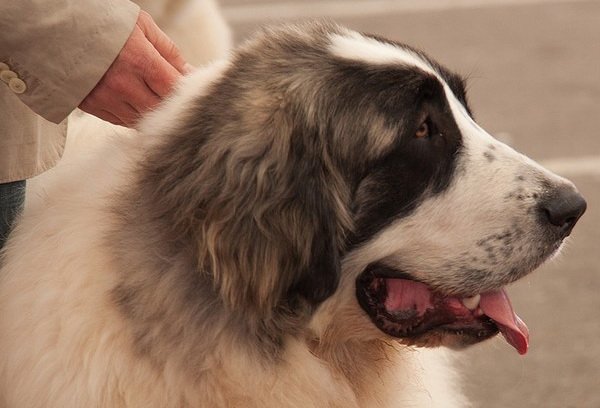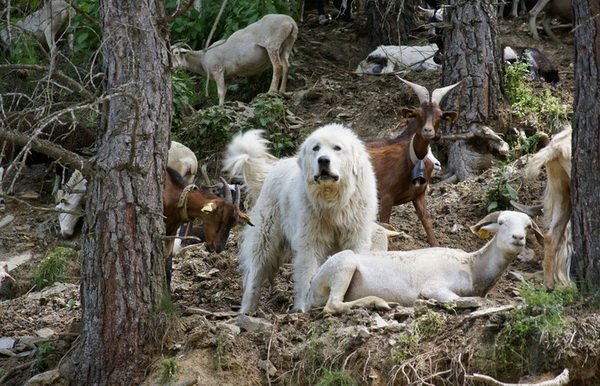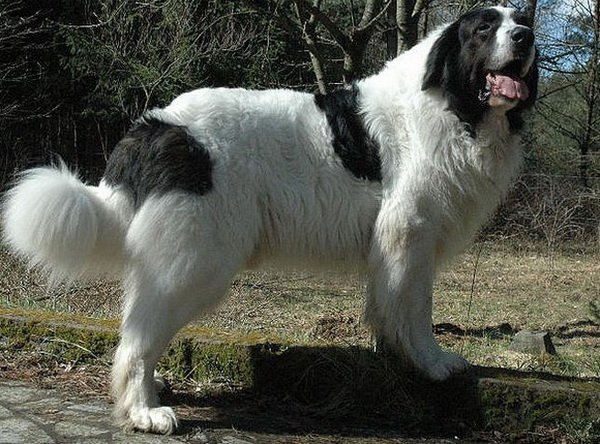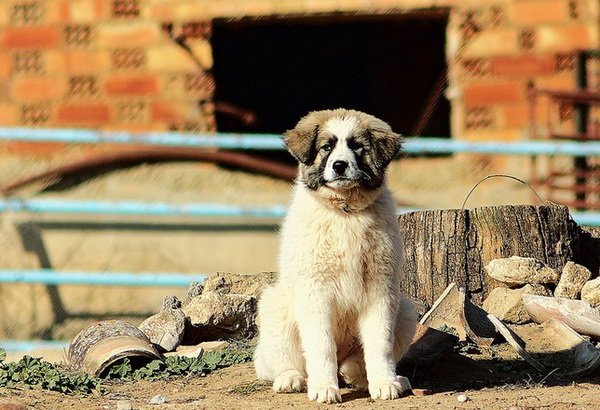Pyrenean Mastiff
The famous "mask" around the eyes, becoming Royal and majestic nobleness to give this great dog a close relative of the St. Bernard and Caucasian shepherd. The Pyrenean Mastiff is a dog of the Moloss family that lives in the Aragonese mountains since ancient times.

There are several theories about how these majestic dogs were born. The most plausible of them claims that mastiffs were brought to the Aragon zone by ancient Phoenicians and their homeland is present Syria and, probably, Tibet. It is from ancient Molossoid happened many Spanish guard dogs, including the Spanish Mastiff and the great Pyrenees dog. They loved the Aragonese shepherds for herding excellent quality, and for many centuries, mastiffs accompanied the flocks in the Pyrenean valleys of Navarre and Valencia. Farmers are very respectful of the improvement of the breed qualities of his loyal helpers, and the dogs reciprocated to them — to this day, Iberian Mastiff is known for his fanatical devotion to his master and his property.
Second birth
In ancient times, when the connection between the regions was still rather weak, each zone produced its own species of this breed, often completely different from each other. This was largely due to the fact that the external characteristics were quite secondary: the greatest attention was paid to herding and guarding qualities. For the first time four — legged mountaineers came to the "beauty platform" only in 1890 at the Madrid dog show-and immediately won the hearts of the audience.

Until the middle of the last century, the Pyrenean mastiffs of different regions of Spain were strikingly different in both size and quality of wool and shape of the head. Aragonese mastiffs were crossed with extremadur and Navarre mastiffs in an attempt to improve the working properties of the breed. In 1946 this "Amateur" came to an end: the breed standard was created, and all mastiffs bred in the North of the country were United under the name "Pyrenean Mastiff". At the same time this also happened with some short-haired dogs of Central Spain who were United in rock "Spanish Mastiff".
In the forties of the XX century Spanish cattle breeding was in a deplorable state: the civil war weakened almost all sectors of the economy. Sheep in the country, exhausted by hunger, practically did not remain, and their faithful guard, the Pyrenean Mastiff, appeared under the threat of disappearance. Only wealthy people could afford the maintenance of a large dog, and mastiffs survived only thanks to wealthy landowners and aristocrats of Aragon.

Their number, however, steadily aspired to zero, and only narrowly in the mid 70-ies a group of enthusiasts managed to find their last representatives, and to resume the work with the breed. Participation in exhibitions have provided this invaluable service, and it's not surprising to see the Pyrenean Mastiff and not to fall in love with him almost impossible. In 1974, one of the mastiffs named Perrault ("dog" in Spanish) made a splash at the dog show and became the first champion of the breed. In 1977 was created the Spanish club lovers of the breed, and in 1981 approved the new, operating today the standard of the Pyrenean Mastiff.

Always in a mask
The Pyrenean Mastiff is a large, broad-boned and solid dog that looks very much like a St. Bernard. The height at the withers for males — a minimum of 77 cm, preferably above 81 cm; bitches — at least 72 cm, preferably higher than 75 cm with the appearance of shaggy hulking Lummox, there's a very agile and extremely alert dog, just knowing the dimensions of the protected area and the number of sheep entrusted to him. The most important feature of the breed is the brand "mask" - dark circles around the eyes and ears. Most valued gray and brown "mask" and spots on cereals, but most often found black on a white or cream background. There are mastiffs and completely monochrome colors, but it is considered a breed marriage, as well as the color of more than two colors. The tip of the tail and lower part of the legs must be white, and the ears are dark.

The weight of these dogs is also serious. By two months the puppies mentioned rocks reach 15 pounds, and the adult dog can weigh all of 90. The coat of the Pyrenean Mastiff is quite stiff and bristly, with a thick undercoat, which makes the dog immune to the harsh cold weather in the mountains. Soft, silky wool is considered disadvantage of, as and too wavy or curly.
A hunter of butterflies
The Mastiff is a real treasure in the family. He is surprisingly affectionate, generous with his masters and infinitely devoted to them. Very independent, which is certainly worth to consider when training a dog: it needs a special approach. In addition, the mastiffs are extremely difficult to tolerate separation from the owners — their love for man truly knows no boundaries. On other dogs he looks down, aware of its superiority. However, in case of danger, this Teddy bear immediately transformed. One of the most valuable qualities of this breed is reckless courage in critical situations. The Pyrenean Mastiff will never retreat in front of the enemy and would rather die than leave his master and his property in trouble. Many centuries of protection of flocks made it a real machine for killing wolves, so to joke with the Mastiff is not recommended. Even a butterfly flying over the protected area, in his mind belongs to the owner, so he can tirelessly pursue it in order to return "to the place."
Unlike other herding dogs of Spain this dog is not adapted for hunting at all. It cannot harm another living being without being threatened by the latter. But as a bodyguard Mastiff is just perfect, he is attentive and feels the danger in his gut.

To keep a dog of this breed in the apartment is strongly not recommended — it needs space and plenty of physical activity, and the Bruin bear is a lot. The optimal space for it-a private house with a plot where you can frolic in plenty.


I love pets! Dog the faithful animal makes the life of owner joyful!